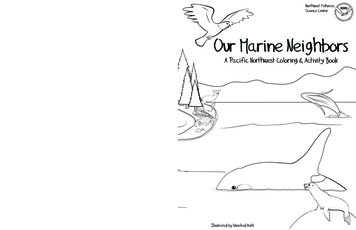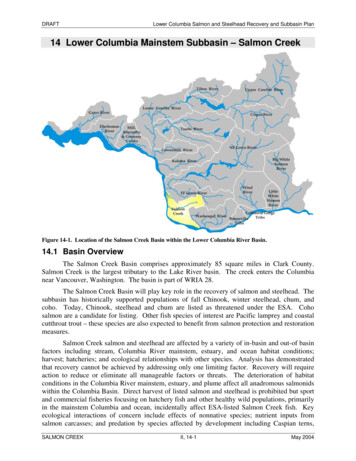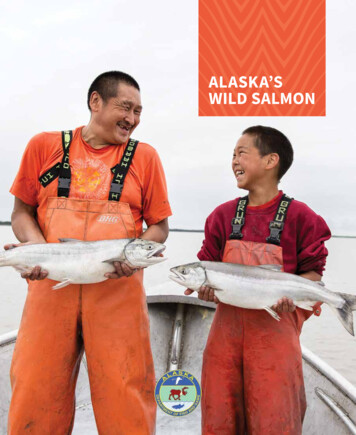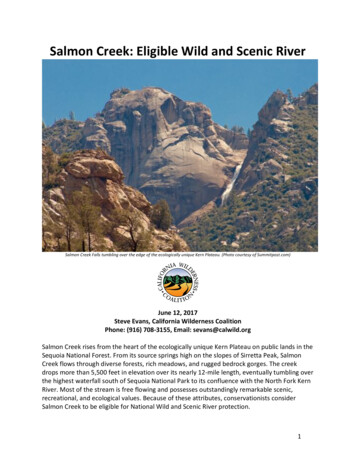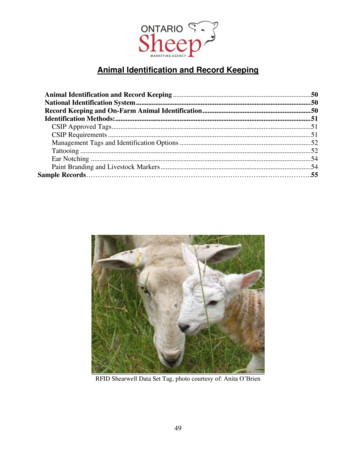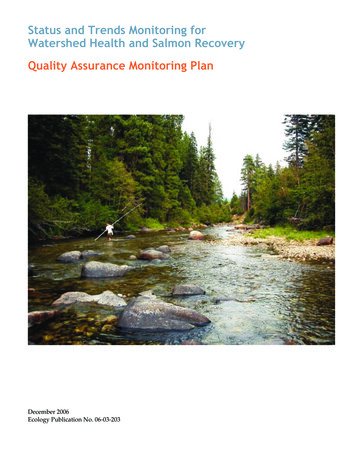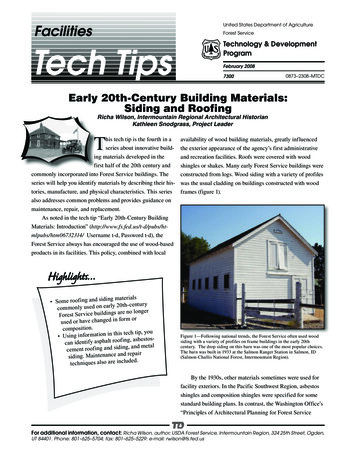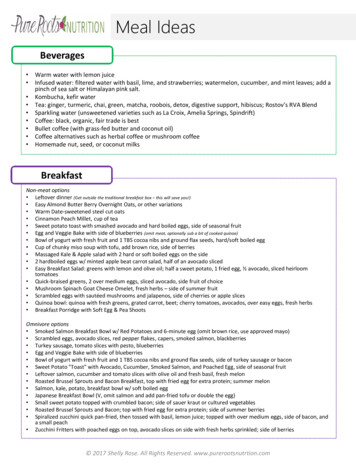
Transcription
Salmon IdentificationOCEAN PHASESPAWNING PHASEChinook SalmonChinook SalmonCoho SalmonCoho SalmonChum SalmonChum SalmonPink SalmonPink SalmonSockeye SalmonSockeye SalmonLarge black spots on back, dorsal fin, and both the upper and lower lobesof the tail. Dark mouth with a black gum line. Average size scales. Silverpigment on the tail. Prominent teeth.Black spots on back with a few spots on the upper portion of the tail.White mouth with a white gum line and dark tongue. Average size scales.Silver pigment on the tail.No prominent spots on back or tail (small speckles may be present).White mouth with a white gum line and dark tongue. Large scales. Caudalpeduncle (tail base) is slender. Silver pigment on the tail.Generally large black spots on back and heavy oval shaped black blotcheson the upper and lower lobes of the tail. White mouth with a black gumline and tongue. Very small scales. No silver pigment on the tail. Flexible(rubbery) lower jaw.No prominent spots on back or tail (small speckles may be present).White mouth with a white gum line and dark tongue. Average size scales.Prominent gold-colored eyes. No silver pigment on the tail. Small teeth.96Chinook salmon do not display the conspicuous morphological changes of pink, chum,and sockeye salmon during the spawning stage. Typically, Pacific salmon turnfrom the silvery bright ocean coloration to a darker bronze color as they approachspawning.In mature male coho salmon, the upper jaw forms an elongated hooked snout andthe teeth become greatly enlarged. The male is generally brighter than that of thefemale and is characterized by the dorsal surface and head turning bluish-green.The sides of the males develop a broad red streak. In females, the jaws alsoelongate but the development is much less extreme than that of the males.Chum salmon display characteristic olive-green and purple (calico) vertical barson the sides of the body as they approach the spawning phase. Both males andfemales develop hooked noses and large canine-like teethAs male pink salmon begin to enter the spawning phase, they develop a prominenthump in front of the dorsal fin, an elongated snout, and large teeth. Body color in bothmales and females darkens from a bright silvery appearance to a pale slate, brownish,or greenish-gray on the back and sides and a pale whitish color below. Small,oblong irregular black spots are present on the back and sides, and on the dorsaland tail fins.Sockeye turn bright red on their body, and olive-green on the head. Males develop aprominent hump in front of the dorsal fin; the male’s snout becomes elongated; andcanine-like teeth grow out of the receding gums. Females undergo a distinct colorchange, but retain their body shape.Learn more by visiting: tml
Atlantic SalmonMale Atlantic salmonFemale Atlantic salmonAtlantic salmon have large black spots on the gill covers and back, and rarely any spots on the tail fin. Their scales are large, there is no red stripealong the lateral line, and they have 8-10 anal fin rays. Atlantic salmon may be taken from marine waters during any open salmon season, and fromanadromous (not landlocked) freshwater during any open salmon or trout season. Anglers may not, however, continue to fish for Atlantic salmon after adaily limit of another species of salmon has been retained. In landlocked lakes, Atlantic salmon may be taken as part of the trout daily limit. Seasons andsize limits in place for trout apply to Atlantic salmon in landlocked lakes. Opportunities to harvest Atlantic salmon beyond those listed in the pamphlet willbe announced to the news media and carried on WDFW's recreational fishing hotline. Please report sightings to (360) 902-2700.ChinookJaw- has a darkmouth and blackgums at the base ofits teeth. Immaturechinook are knownas a “blackmouth.”CohoJaw- mouth iswhite and thegum line is almostwhite, but thetongue may beblack. The teethare sharp andstrong.PinkJaw- mouth of apink is white, butthe gums andtongue are black,as they are in aChinook. It doesnot have “teeth” onits tongue.Tail- both the upperand lower lobes ofthe tail are coveredwith spots andsilver is prominent.Tail- has just a fewscattered spots,usually on theupper lobe, withsilver streaks. Ithas a wide caudalpeduncle.Tail- is coveredwith large ovalspots. It does nothave silver on thetail. The scalesare very smallcompared to othersalmon of thesame size.Wild/Hatchery IdentificationIn order to provide salmon & steelhead fishingopportunities, WDFW and the Tribes have markedsalmon & steelhead by clipping theadipose fin (a small fatty fin directly behind thedorsal fin). In areas designated "release wild insert fish name ", fin-clipped salmon andsteelhead are the only fish that may be retained.The picture to the right shows a wild coho salmonand a fin-clipped or hatchery coho salmon. Pleasebe careful in releasing wild fish– they are yourfishing future! For tips on the best way to releasefish, please see page 13. In Marine Areas 5-13, it isillegal to bring a wild salmon or a species of salmonaboard a vessel if it is unlawful to retain thosesalmon. "Aboard a vessel" is defined as inside thegunwale. In Marine Area 2-2, it is unlawful to totallyremove salmon from the water if it is illegal to retainthose fish, except anglers fishing from boats 30' orlonger are exempt.Hatchery cohoAdipose fin has beenclipped – leaving ahealed scar inits place.Wild cohoIntact adipose fin.Learn more by visiting: tml97Marine AreasChinook, Coho, and Pink Salmon Identification
. . . . . . .12Marine Area RulesSeason and Daily Hours:During an open season, marine waters are open 24 hours per day, except as noted for night closures.Quota Management:SALMON, HALIBUT, and some SHELLFISH are managed by quotas in many marine areas. These fisheries closewhen the quotas have been taken. Closures will be announced to local news media and will be included in theFishing Hotline and Shellfish Rule Change Hotline messages.NOTE: Emergency rules may occur throughout the year and will supersede the rules contained in this pamphlet. Changes can be found bycalling the WDFW Fishing Hotline (360) 902-2500 or Shellfish Rule Change Hotline (866) 880-5431, contacting statewide customer service (360) 9022700, or by visiting the WDFW website http://wdfw.wa.gov.Rules listed below are General Rules. Specific Area Rules are listed by area.Species RulesSpecies RulesHatchery STEELHEAD may be caught andreleased until the daily limit is retained. If a fish hasswallowed the hook or is hooked in the gill, eye,or tongue, it should be kept if legal to do so. WildSTEELHEAD must be released.FORAGE FISH - Forage fish jig or forage fish dipnet only. Only one dip net may be used at a time.Gear must be held by the rigid handle at all timesand may not be used from a vessel while underpower. Anglers with the reduced-fee license or aDesignated Harvester Card may use a forage fishdip net with a hand-operated gate. Jig gear mayhave up to three treble hooks or nine single-pointhooks, not to exceed ⅜" between point and shank.While fishing in Areas 5-11 &13, a second lineusing forage fish jig gear may be used to fish forforage fish.Salmon - Barbless hooks only. Only singlepoint hooks and a hand-held rod and linemay be used in Areas 1-13. Minimum size forchinook in Areas 1-4 is 24", in Areas 5-13,22", except no minimum size in the HoodsportHatchery Zone. Minimum size for coho in Areas1-4 is 16"; except in Area 2-1 after July 31 andArea 2-2 east of the buoy 13 line after Sept. 15,the minimum size is 12" for all salmon. OtherMarine Areas and species - no minimum size.Handling Rule: in Areas 5-13, it is illegal to bringa wild SALMON or a species of SALMON aboarda vessel if it is unlawful to retain those SALMON."Aboard a vessel" is defined as inside the gunwale.Also see special Handling Rule for Area 2-2 forSept. 16-Nov. 30.WHITE Sturgeon - Only one single-pointbarbless hook and bait is allowed when fishing forSTURGEON. Catch-and-release open year-round.Refer to specific Marine Area rules for retentiondates. Green STURGEON may not be retained.Halibut - Hook and line angling and spearfishingonly. A hand-held line is permitted. Only one linewith up to two hooks may be used. Halibut maybe shot or harpooned while landing. May not belanded in a port closed to halibut fishing excepthalibut lawfully caught in Canada; angler musthave Canadian license. See page 12, Fish &Shellfish caught in Canada.Bottomfish, Tuna, and Mackerel Hook and line angling, spearfishing, and bow andarrow fishing only.RockFISH - You may not land YELLOWEYE orCANARY rockfish into any port in Washington.Unlawful to fish for or retain rockfish in Areas 6-13.UNCLASSIFIED MARINE FISH - CLOSEDOTHER FOOD FISH - These are species whichoccur in our waters irregularly, usually in coastalareas and include barracuda, white seabass, bonito, yellowtail, and pomfret.Daily limit is two of each species.SIXGILL SHARK - It is illegal to retain or removeSIXGILL sharks from the water in Areas 5-13.98You may use forage fish jig gear in ColumbiaRiver waters from the Buoy 10 line to the RockyPoint/Tongue Point line.Possession LimitsVESSEL LIMITS Marine areas 1-6: Anglersaboard a boat may only possess one daily limit offish or shellfish in fresh form.Salmon - Two daily limits of fresh salmon.An additional 40 pounds of salmon may bepossessed in a frozen or processed form (seepages 10-11).Trout - Two daily limits of hatcherysteelhead.Sturgeon - Two daily limits in any form.Statewide annual limit 5.Bottomfish - Two daily limits in any form.Halibut - Two daily limits in any form, exceptonly one limit while aboard the fishing vessel. ForHALIBUT caught in Canadian waters, contactDepartment of Fisheries and Oceans Canada(DFO) or visit their website at finfish e.htm. forupdated Canadian regulations.TUNA - ALBACORE, YELLOWFIN, SKIPJACK,and NORTHERN BLUEFIN and MACKEREL No possession limit or daily limit.SHELLFISH - One daily limit of freshSHELLFISH. Additional shellfish may bepossessed in a frozen or processed form. Seepage 124 for Shellfish/Seaweed rules and page127 for the shellfish health advisory.Forage fish (herring, anchovies,sardines, sand lance, and smelt) Two daily limits in fresh form. Additional foragefish may be possessed in frozen or processedform. CLOSED to fishing for Columbia RiverSMELT (eulachon). See description on nextpage.Tackle/Gear RulesAll Fishing Gear - Must be kept in immediatecontrol, and gear may not be left unattended whilefishing.Hook and line angling - Unless noteddifferently, only one line with up to 2 hooks isallowed.Barbless hooks are required for all speciesin Marine Areas 5-13, except forage fish jiggear.When fishing for SALMON in Marine Areas 1-13,only single-point barbless hooks may be used.FORAGE FISH DIPNET - A section of netting(maximum mesh size is ⅝" stretched mesh) distended by a rigid frame not exceeding 36" acrossand directly attached to a rigid handle. May only beused for forage fish or squid.Landing a Fish - A club or dipnet (landing net)may be used to assist landing a legal fish takenby legal gear. A gaff may only be used to land alegally hooked halibut, tuna, or dogfishshark that will be retained. HALIBUT may beshot or harpooned while landing.Downriggers - May be used with a line if theline releases from the downrigger while playingand landing the fish.Rodholders - May be used; the rod must beeasily removed without delay; rod may be left inthe holder while playing the fish.Electric Reels - May be used if designed forsport fishing and attached to a fishing rod.Spearfishing - The diver must be swimming orfloating in the water while spearfishing. The use ofexplosives or bullets attached to the spear ("bangsticks") is prohibited.In Washington waters where a saltwaterlicense is valid, each angler aboard avessel may continue to deploy anglinggear or shellfish gear until the dailylimit of fish and shellfish for all licensedand juvenile anglers aboard has beenachieved.
Marine Area Definitions and CodesAREA DEFINITIONS AND SHLINEBELLINGHAMANACORTES44SEKIU5MOUTH OFSEKIU ASHINGTON8-1.BREMERTONNSEATTLE112TACOMAOCEAN SHORESHOQUIAMABERDEEN2-2GRAYS HARBORBUOY 13WESTPORTLEADBETTERPOINT5.7.MOUTHOF QUEETSRIVERPT. BROWN3.4.SAN JUAN LOPEZISLAND OLYMPIA9.CAPE SHOALWATER1NORTH HEADROCKY POINT10.BUOY 10SOUTH JETTY11.TONGUE POINT12.13.Columbia River Smelt (eulachon)Size: up to 13"Color: bluish on upper half with silvery white sides and belly.Look for: grooves on gill cover, skinny head, speckeled tail.ILWACO - west of the Buoy 10 line at theColumbia River mouth, north to LeadbetterPoint.WESTPORT-OCEAN SHORES- fromLeadbetter Point north to the Queets River,excluding Willapa Bay and Grays Harbor.WILLAPA BAY - east of a line fromLeadbetter Point to Cape Shoalwater.GRAYS HARBOR - east of a line from theoutermoust tip of the north jetty to outermostexposed end of the south jetty.LAPUSH - from the Queets River north toCape Alava.NEAH BAY - from Cape Alava north andinside Juan de Fuca Strait to the Sekiu River.SEKIU AND PILLAR POINT - from mouth ofthe Sekiu River east to Low Point, mouth ofthe Lyre River.EAST JUAN DE FUCA STRAIT - from LowPoint east to the Partridge Point - PointWilson line, north to the line from TrialIsland (near Victoria B.C.) - Vessel TrafficSeparation Buoy "R" - Smith Island to theLawson Reef Buoy, to Northwest Island, tothe Initiative 77 marker on Fidalgo Island.SAN JUAN ISLANDS - all marine watersnorth of the Trial Island line (describedunder Area 6) to the United States-Canadaboundary.DECEPTION PASS, HOPE ISLAND,AND SKAGIT BAY - from West Pointto Reservation Head eastward throughDeception Pass, including all waters ofSwinomish Slough and Skagit Bay, and theportion of Saratoga Passage north and westof a line from East Point Light to light onCamano Island (Saratoga Pass Light #4FlRed 4 Sec.).PORTS SUSAN AND GARDNER - east ofEast Point Light-Camano Island Light line(described in 8-1 above) and north of thePossession Point-Shipwreck line (describedin 9 below).ADMIRALTY INLET - all waters inside andsouth of the Partridge Point - Point Wilsonline, south and west of a line from PossessionPoint 110 true to shipwreck, north of theHood Canal Bridge, and north of the AppleCove Point-Edwards Point line.SEATTLE-BREMERTON AREA - south fromthe Apple Cove Point-Edwards Point line toa line projected true east- west through thenorth tip of Vashon Island.TACOMA-VASHON ISLAND - south froma line projected true east west through thenorth tip of Vashon Island to the northernmostTacoma Narrows Bridge.HOOD CANAL - all waters south of the HoodCanal Bridge.SOUTH PUGET SOUND - all waters south ofnorthernmost Tacoma Narrows Bridge.Marine AreasVANCOUVERISLANDSurf SmeltSize: up to 8"Color: silver with a stripe along the side.Look for: small adipose fin and stripe on the side.99
Marine Area 1 - Ilwaco(West of the Buoy 10 line at the Columbia River mouth, north to Leadbetter Point)SPECIESSEASONADDITIONAL RULESSALMON - ENTIRE AREAJune 9-June 22CHINOOK - min. size 24". Other SALMON species - no min. size. Daily limit 2 (combined).Release COHO and wild CHINOOK.Season may close earlier if coastwide guideline of 8,000 CHINOOK is attained. SeeControl Zone 1 closure below.June 23-Sept. 30CHINOOK - min. size 24". COHO - min. size 16". Other SALMON species - no min.size. Daily limit 2 (combined). Only 1 CHINOOK may be retained. Release wild COHO.Season may close earlier if quota of 34,860 hatchery COHO or 11,100 CHINOOKguideline is attained. See Control Zone 1 closure below.TROUTYear-roundCatch-and-release except up to 2 hatchery STEELHEAD may be retained.STURGEONYear-roundMin. size 38" fork length. Max. size 54" fork length. Daily limit 1. Release GREENSTURGEON.TUNA and MACKERELYear-roundNo min. size. No daily limit.HERRING, SMELT, ANCHOVY,SARDINE, and SAND LANCEYear-roundNo min. size. Daily limit 10 lbs., all species combined. All SMELT caught must be keptand count toward the daily limit except Closed to Columbia River SMELT (eulachon).PACIFIC HALIBUTMay 3-quota or July 14, Open Thursdays through Saturdays ONLY. No min. size. Daily limit 1. Retention ofwhichever comes firstbottomfish, except sablefish and Pacific cod, is prohibited with a halibutonboard. Season may close earlier if quota is attained. Season will re-open August 3(Friday-Sunday) until remaining quota is taken.BOTTOMFISHYear-round season. Daily limit is 12 BOTTOMFISH (see definition page 10) regardless of species, subject toindividual limits and seasons shown below. No BOTTOMFISH (except SABLEFISH and Pacific cod) may belanded in Area 1 if a HALIBUT is onboard from May 1 - Sept. 30.Mar. 17-Oct. 13, 2012Min. size 22". Daily limit 2. No retention or possession seaward of a line drawn fromReopens Mar. 16, 2013 46 38.17' N Lat., 124 21.00' W Lon., to 46 25.00' N Lat., 124 21.00' W Lon.LINGCODSURFPERCHYear-roundNo min. size. Daily limit 12. Except SHINER PERCH daily limit 15: not included inBOTTOMFISH limit.ROCKFISHYear-roundNo min. size. Daily limit 10. No CANARY or YELLOWEYE may be retained.CABEZONYear-roundNo min. size. Daily limit 2.OTHER FOOD FISHALL OTHER FISHYear-roundNo min. size. Daily limit 2 of each species.Year-roundCLOSEDControl Zone 1: An area at the Columbia Rivermouth bounded on the west by a line runningnortheast/southwest between the red lightedBuoy #4 (46 13'35"N/124 06'50"W) and the greenlighted Buoy #7 (46 15'09"N/124 06'16"W); on theeast by the Buoy #10 line which bears north/southat 357 true from the south jetty at 46 14'00"N/124 03'07"W to its intersection with the northjetty; on the north by a line running northeast/southwest between the green lighted Buoy #7 tothe tip of the north jetty (46 14'48"N/124 05'20"W),and then along the north jetty to the point of intersection with the Buoy #10 line; and on the southby a line running northeast/southwest between thered lighted Buoy #4 and the tip of the south jetty(46 14'03"N/124 04'05"W), and then along thesouth jetty to the point of intersection with the Buoy#10 line, is CLOSED to fishing for SALMON at alltimes except open to fishing from the north jettywhen adjacent waters north of the Control Zoneare open to fishing for SALMON or the Buoy 10fishery is open.IlwacoNorthJettyTipGreen Buoy #7Red Buoy #4NorthJettyBaseBuoy #10Control Zone 1Buoy 10 season: See Columbia River listing in Eastside Rivers-Special Rules section.Buoy 10 Line: Defined as a true north and south lineprojected through Buoy 10, which marks the channel leading into the Columbia River at its mouth (aline from the Lewis and Clark Interpretive Centeratop Cape Disappointment Rock through Buoy 10to the south jetty).McKenzieHeadSouthJettyTipColumbia RiverClatsop SpitColumbia River North Jetty: The jetty is open to fishing for SALMON 7 days a week when the Buoy 10 or the Marine Area 1 SALMON fishery is open.Daily limit and minimum size restrictions follow the most liberal regulations of either area. Barbed hooks allowed.Reciprocity Rules: When angling from a boat in the concurrent waters of the Columbia River or the Pacific Ocean within 3 miles of shore between CapeFalcon, Oregon, and Leadbetter Point, Washington, either a Washington or an Oregon fishing license is valid.100
Rockfish IdentificationYelloweye RockfishOrange-red to yellow bodycolor, bright yellow eye,and fins may be tinged withblack. Raspy ridges aboveeye, rear of anal fin vertical.Also called raspheadrockfish and red snapper.A large rockfish.Black RockfishBody black or grey incolor. Also called seabassand black bass. Largemouth, rounded anal fin.Copper RockfishBody variable in color with light colored stripe along the rear of thelateral line. Two dark bars radiating from eye.Brown RockfishBody very mottled withdark brown, tan, andsometimes reddish hue.Fins tinged with pink.Noticeable dark spot ongill cover.Blue RockfishBody is blue or black. Forehead has several diagonal bars. Has asmall mouth. The anal fin is vertical or slanted posteriorly.China RockfishBody blue or black spotted with yellow and white.Prominent yellow stripeextending from top ofback to along lateral lineto caudal fin.Bocaccio RockfishBody orange, olive, or brown. Large mouth extending past rear ofeye, and projecting lower jaw.Body brown with yellowmottling. High fin on backwith yellow mottling. Mayhave freckles on head andthroat. Two light saddlepatches on top of back.Vermillion RockfishBody dark red and mottled gray. Red mouth and underside of jawis rough. Fins may be edged with black. Anal fin rounded.Canary RockfishBright orange or yellowbody, mottled with grey.Fins are orange withoutblack edge. Threeorange stripes across thehead. Chin smooth to thetouch. Anal fin sharp andangular.Yellowtail RockfishOlive green body with yellow-green fins. May have knob at tip oflower jaw. Rear edge of anal fin vertical.Rockfish photos courtesy of Alaska Sea Grant, Steve Axtell, and Wayne Palsson101Marine AreasQuillback Rockfish
Marine Area 2 - Westport - Ocean ShoresMarine Area 2-1 (Willapa Bay) and Marine Area 2-2 (Grays Harbor)Marine Area 2 Definition: from Leadbetter Point north to the Queets River, excluding Willapa Bay and Grays HarborMarine Area 2-1 (Willapa Bay) Definition: east of a line from Cape Shoalwater to Leadbetter PointMarine Area 2-2 (Grays Harbor) Definition: east of a line from the tip of the north jetty to exposed end of the south jettySPECIESSALMON - AREA 2SEASONJune 9-June 23ADDITIONAL RULESCHINOOK - min. size 24". Other SALMON species - no min. size. Daily limit 2 (combined).Release COHO and wild CHINOOK.Season may close earlier if coastwide guideline of 8,000 CHINOOK is attained.June 24-Sept. 23Open Sundays through Thursdays ONLY. CHINOOK - min. size 24". COHO - min. size16". Other SALMON species - no min. size. Daily limit 2 (combined). Only 1 CHINOOKmay be retained. Release wild COHO. Season may close earlier if quota of 25,800hatchery COHO or 25,600 CHINOOK guideline is attained.AREA 2-1(east of a line from CapeShoalwater to Leadbetter Pt.)June 9-July 31Open concurrent with the ocean (Area 2) for SALMON. Area 2 rules apply.Aug. 1-Jan. 31Min. size 12". Daily limit 6. Up to 3 adults may be retained. Release wild CHINOOK andCHUM. Anglers may fish with two poles with Two-Pole Endorsement.AREA 2-2 (west of Buoy 13 line)June 9-Sept. 23Open concurrent with the ocean (Area 2) for SALMON. Area 2 rules apply.AREA 2-2(east of the Buoy 13 line)ALL SALMON required to be released may not be totally removed from the water, except anglers fishing from boats 30'or longer as listed on either their state or Coast Guard registration are exempt.Sept. 16-Oct. 7Min. size 12". Daily limit 3 of which only 1 may be a CHINOOK and 2 may be wildCOHO. Release CHUM.Oct. 8-Nov. 30Min. size 12". Daily limit 3 of which only 2 may be wild COHO. Release CHINOOK andCHUM.Westport Boat Basin and OceanShores Boat BasinAug. 16-Jan. 31Min. size 12". Daily limit 6. No more than 4 adults may be retained. Release wildCHINOOK. Night closure and anti-snagging rule. Only single-point barbless hooks maybe used.TROUTYear-roundCatch-and-release except up to 2 hatchery STEELHEAD may be retained.STURGEONYear-roundMin. size 38" fork length. Max. size 54" fork length. Daily limit 1. Release GREENSTURGEON.TUNA and MACKERELYear-roundNo min. size. No daily limit.HERRING, SMELT, ANCHOVY,SARDINE, and SAND LANCEYear-roundNo min. size. Daily limit 10 lbs., all species combined. All SMELT caught must be keptand count toward the daily limit except Closed to Columbia River SMELT (eulachon).PACIFIC HALIBUTMay 6-quota or Sept. 30, Open Sunday May 6, Sundays and Tuesdays ONLY, except CLOSED May 27,whichever comes first29. If sufficient quota remains, the fishery will re-open June 3 and or June 5. No min.size. Daily limit 1. See Northern Nearshore HALIBUT Fishery and HALIBUT andBOTTOMFISH closure areas below.BOTTOMFISHLINGCODSURFPERCHYear-round season. Daily limit is a total of 12 BOTTOMFISH (see definition page 10) regardless of species,subject to individual limits and seasons shown below. See HALIBUT and BOTTOMFISH closure areas and 30fathom restriction below.Mar. 17-Oct. 13, 2012Min. size 22". Daily limit 2. No retention or possession seaward of a line approximatingReopens Mar. 16, 2013 30 fathoms March 15-June 15 (except when the primary halibut season is open). See30 fathom restriction below. No retention or possession south of 46 58' N. and seawardof 30 fathoms on Fridays and Saturdays July 1-Aug. 31. No retention or possessionseaward of a line drawn from, 47 31.70' N Lat., 124 45.00' W Lon. to 46 38.17' N Lat.,124 30.00' W Lon. (except when the primary halibut season is open).Year-roundNo min. size. Daily limit 12. Except SHINER PERCH daily limit 15: not included inBOTTOMFISH limit.ROCKFISHYear-roundNo min. size. Daily limit 10. No CANARY or YELLOWEYE may be retained.CABEZONYear-roundNo min. size. Daily limit 2.OTHER FOOD FISHALL OTHER FISHYear-roundNo min. size. Daily limit 2 of each species.Year-roundCLOSEDBuoy 13 Line: A line drawn true north-south through Buoy13 near the entrance of Grays Harbor.Grays Harbor Control Zone: An area at the entrance toGrays Harbor bounded by a line from the lighthouse 1mile south of the south jetty to buoy #2 to buoy #3 to thetip of the north jetty to the tip of the exposed end of thesouth jetty.Westport Boat Basin: A portion of Grays Harbor lyinginside the boat basin breakwater and inside lines drawnfrom lighted day markers 10 to 11 and 1 to 2.Northern Nearshore Halibut Fishery: Open toHALIBUT fishing beginning May 6, seven days per weekuntil the sub-quota is reached or Sept. 30 for thosewaters from 47 31.70' N. latitude south to 46 58.00'N.latitude and east of a line approximating 30 fathoms asdefined by the following coordinates:47 31.70'N, 124 37.03'W,47 25.67'N, 124 34.79'W,47 12.82'N, 124 29.12'W,46 58.00'N, 124 24.24'W102Halibut and Bottomfish Closure AreasFishing for HALIBUT and BOTTOMFISH isclosed and anglers may not fish for SALMONwith BOTTOMFISH aboard in these areas:South Coast YRCA described beginning at:46 58.00'N, 124 48.00'W, and continuing to46 55.00'N, 124 48.00'W, then to46 55.00'N, 124 49.00'W, then to46 58.00'N, 124 49.00'W, then toand back to the point of origin.Westport Offshore YRCA beginning at:46 54.30'N, 124 53.40'W, and continuing to46 54.30'N, 124 51.00'W, then to46 53.30'N, 124 51.00'W, then to46 53.30'N, 124 53.40'W30 fathom restrictionMar. 15-June 15: fishing for or possessionof BOTTOM FISH, except ROCKFISH, isprohibited seaward of a line approximating30 fathoms, except LINGCOD retentionpermitted on days primary HALIBUT seasonis open. SABLEFISH, and PACIFIC CODpermitted May 1-June 15 from Queets Riversouth to Leadbetter Pt., as described by thefollowing coordinates:47 31.70'N, 124 37.03'W,47 25.67'N, 124 34.79'W,47 12.82'N, 124 29.12'W,46 52.94'N, 124 22.58'W,46 44.18'N, 124 18.00'W,46 38.17'N, 124 15.88'W.NOTE: In Areas 2-1 and 2-2, anglers may use either a freshwater, saltwater, or combination license.
Marine Area 3 - LaPushSPECIESSALMON - ENTIRE AREASEASONJune 16-June 30ADDITIONAL RULESCHINOOK - min. size 24". Other SALMON species - no min. size. Daily limit 2(combined). Release COHO and wild CHINOOK.Season may close earlier if coastwide guideline of 8,000 CHINOOK is attained.July 1-Sept. 23CHINOOK - min. size 24". COHO - min. size 16". Other SALMON species - no min.size. Daily limit 2 (combined). Release wild COHO. Season may close earlier if subquota of 1,760 hatchery COHO or 2,050 CHINOOK guideline is attained. Note:season may change depending on inseason catch projections. See wdfw.wa.gov.LaPush Late Season Area(see below for boundaries)Sept. 29-Oct. 14CHINOOK - min. size 24". COHO - min. size 16". Other SALMON species - no min.size. Daily limit 2 (combined). Release wild COHO. Season may close earlier if subquota of 50 hatchery COHO or 50 CHINOOK quota is attained.TROUTYear-roundCatch-and-release except up to 2 hatchery STEELHEAD may be retained.STURGEONYear-roundMin. size 38" fork length. Max. size 54" fork length. Daily limit 1. Release GREENSTURGEON.TUNA and MACKERELYear-roundNo min. size. No daily limit.HERRING, SMELT, ANCHOVY,SARDINE, and SAND LANCEYear-roundNo min. size. Daily limit 10 lbs., all species combined. All SMELT caught must be keptand count toward the daily limit except Closed to Columbia River SMELT (eulachon).PACIFIC HALIBUTMay 10-quotaOpen Thursdays and Saturdays ONLY through May 19. HALIBUT fishery CLOSEDMay 24-26. If sufficient quota remains, the fishery will re-open May 31 and or June 2.Additional openings may occur with sufficient quota see wdfw.wa.gov. No min. size. Dailylimit 1. See HALIBUT and BOTTOMFISH closure area below.BOTTOMFISHYear-round season. Daily limit is a total of 12 BOTTOMFISH (see definition page 10) regardless of species,subject to individual limits and seasons shown below. No retention or possession of bottomfish seaward of lineapproximating 20 fathoms June 1-Sept. 30 (except when halibut is open). See 20 fathom restriction below.Note HALIBUT and BOTTOMFISH Closure Area below.Mar. 17-Oct. 13, 2012Min. size 22". Daily limit 2.Reopens Mar. 16, 2013LINGCODSURFPERCHYear-roundNo min. size. Daily limit 12. Except SHINER PERCH daily limit 15: not included inBOTTOMFISH limit.ROCKFISHYear-roundNo min. size. Daily limit 10. No CANARY or YELLOWEYE may be retained.CABEZONYear-roundNo min. size. Daily limit 2.OTHER FOOD FISHALL OTHER FISHYear-roundNo min. size. Daily limit 2 of each osh LineArea 4Mouth ofSekiu Riveratho20 fHalibut & BottomfishClosure AreaKydakaPointmsCapeAlavaArea 5Area 3Mouth ofQueets RiverHalibut and Bottomfish Closure Area ("C"-shaped YRCA)Fishing for halibut and bottomfish is closed, and anglers ma
from the silvery bright ocean coloration to a darker bronze color as they approach spawning. Coho Salmon In mature male coho salmon, the upper jaw forms an elongated hooked snout and the teeth become greatly enlarged. The male is generally brighter than that of the female and is characterized by the dorsal surface and head turning bluish-green.

